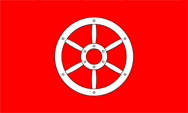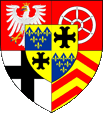Frankfurt |
|
|
|
| Übersicht – Contents: | |
Diese Seite ist Teil des Projektes
Frankfurt |
|
|
|
| Übersicht – Contents: | |
| Flagge – Flag: | |
 |
1803–1810, Flagge Großherzogtum Frankfurt – flag of the Grand Duchy of Frankfurt, Quelle/Source, nach/by: World Statesmen |
|
|
|
| Die Flagge zeigte das Bild des Wappens, das seine Wurzeln im Kurfürstentum Mainz hatte. Das Großherzogtum Frankfurt bestand größtenteils aus Restgebieten des ehemaligen Kurfürstentums Mainz, und wurde vom ehemaligen Kurfürsten und Erzbischof von Mainz, dem Fürstprimas Karl Theodor von Dalberg als Landesfürsten regiert. Der Fürstprimas war zunächst Fürst von Aschaffenburg, 1810 wurden Frankfurt, Hanau und Fulda angeschlossen, und so das Großherzogtum Frankfurt gebildet, die Flagge von Aschaffenburg wurde beibehalten, und auch die Residenz des Fürstprimas verblieb in Aschaffenburg. | The flag
showed the depiction of the coat of arms, which had its roots in the
Electorate of Mainz. The Grand Duchy of Frankfurt, was mostly formed from
rest areas of the Electorate of Mainz, and was reigned by the former Elector
and Archbishop of Mainz, the Prince Primate Karl Theodor von Dalberg as
sovereign. The Prince Primate was initially Prince of Aschaffenburg, in 1810 were annexed the areas of Frankfurt, Hanau and Fulda, and in this way it became formed the Grand Duchy of Frankfurt, the flag of Aschaffenburg was retained, and also the residence of the Prince Primate remained in Aschaffenburg. |
| Quelle/Source: Volker Preuß | |
| Wappen – Coat of Arms: | |
 |
Wappen Großherzogtum Frankfurt – coat of arms Grand Duchy of Frankfurt |
| Quelle/Source, nach/by: Wikipedia (EN) | |
| Der ehemalige Kurfürst von Mainz und Reichserzkanzler, Karl Theodor von Dalberg, bekam Aschaffenburg nach dem Ende des Kurfürstentums Mainz übertragen. Er übernahm die Heraldik von Mainz und übertrug sie auf das Fürstentum Aschaffenburg, das territorial ein ehemaliger Bestandteil des Kurfürstentums Mainz war. Das kann man daran erkennen, dass im Wappen des späteren Großherzogtums Frankfurt das Mainzer Rad als Platzhalter für Aschaffenburg im zweiten Feld enthalten ist. Im Jahre 1810 wurden Frankfurt, Hanau und Fulda angeschlossen, daraus das Großherzogtum Frankfurt gebildet. Das Feld 1 des Wappens zeigt die Heraldik von Frankfurt (Adler), das Feld 3 Fulda (Kreuz). das Feld 4. Hanau (Sparren). Das Herzschild ist das Wappen der Familie von Dalberg. | The
former Elector of Mainz and Reichserzkanzler, Karl Theodor von Dalberg, got Aschaffenburg transferred
after the end of the Electorate of Mainz. He took over the heraldry of Mainz
and transferred it to the Principality of Aschaffenburg. The territory was a former part of the Electorate of Mainz. This can be seen from the fact, that in the later coat of arms of the Grand Duchy of Frankfurt is included the Wheel of Mainz as a placeholder for Aschaffenburg in the second field. In 1810 were annexed the areas of Frankfurt, Hanau and Fulda, and in this way it became formed the Grand Duchy of Frankfurt. Field 1 of the coat of arms shows the heraldry of Frankfurt (eagle), field 3 Fulda (cross). the field 4. Hanau (rafters). The heart shield is the coat of arms of the von Dalberg family. |
| Quelle/Source: Wikipedia (D), Volker Preuß | |
| Landkarte – Map: | |
|
|
| Die Landkarte zeigt das Großherzogtum Frankfurt zwischen 1810 und 1813, in roter Umrandung. | The map shows the Grand Duchy of Frankfurt between the years 1810 and 1813, within a red border. |
| Zahlen und Fakten – Numbers and Facts: | |
|
|
|
|
|
|
|
|
|
|
|
|
|
1792, 1796, 1800 und 1805 · Invasionen französischer
Revolutionstruppen unter Napoléon in das Deutsche
Reich, das Deutsche Reich unterliegt und wird von Napoléon territorial
umgestaltet 1801 · alle linksrheinischen Gebiete werden an Frankreich abgetreten und von diesem einverleibt 1803 · Reichsdeputationshauptschluss, Umgestaltung der territorialen Gliederung des Deutschen Reiches, geistliche Besitzungen werden enteignet, alte Fürstenterritorien und freie Städte werden enteignet oder aufgehoben und alten oder neuen Fürstentümern übertragen, die Zahl der Gebietskörperschaften des Reiches wird dadurch von 300 auf 60 reduziert – das Bistum und Kurfürstentum Mainz wird auf diesem Wege aufgehoben, der Kurfürst von Mainz und Reichserzkanzler erhält aus dem Bestand des ehemaligen Kurfürstentums Mainz die Gebiete Aschaffenburg, Klingenberg, Orb und Lohr als Fürstentum Aschaffenburg, und zusätzlich das Fürstentum Regensburg 12.07.1806 · Napoléon erzwingt die Gründung des Rheinbundes, ein Zusammenschluss von sechzehn süd- und südwestdeutschen Staaten unter französischem Protektorat, das Fürstentum Aschaffenburg und das Fürstentum Regensburg gehören zu den Gründungsmitgliedern, der Fürst beider Länder, der ehemalige Kurfürst und Erzbischof von Mainz, Fürstprimas Karl Theodor von Dalberg, erhält am 19.09.1806 zusätzlich die ehemalige Freie Reichsstadt Frankfurt als Fürstentum Frankfurt 01.08.1806 · die Staaten des Rheinbunds treten aus dem Heiligen Römischen Reich Deutscher Nation aus 06.08.1806 · Kaiser Franz II. legt die Krone des Heiligen Römischen Reiches Deutscher Nation nieder, das Reich endet 16.02.1810 · Napoléon übergibt das Fürstentum Regensburg (der Fürst von Aschaffenburg ist gleichzeitig auch Fürst von Regensburg) an Bayern, der Fürst von Asschaffenburg wird mit den Gebieten Hanau und Fulda entschädigt, diese werden an Aschaffenburg angeschlosen und am 19.02.1810 wird durch Vereinigung dieser Territorien mit dem Fürstentum Frankfurt das Großherzogtum Frankfurt gegründet 30.09.1813 · Großherzog Karl Theodor von Dalberg verlässt das Land Oktober 1813 · Niederlage Napoléons bei Leipzig, das Großherzogtum Frankfurt beginnt sich aufzulösen 28.10.1813 · Großherzog Karl Theodor von Dalberg verzichtet auf die Krone des Großherzogtums und dankt zugunsten von Napoléons Stiefsohn Eugène de Beauharnais ab 1815 · Wiener Kongress, Neuordnung Europas nach der Ära Napoléon, die Besitzverhältnisse und die Raumordnung im ehemaligen Deutschen Reich werden wieder hergestellt, jedoch nicht die Souveränität der geistlichen Länder, deren Besitzungen werden alten oder neuen Fürstentümern übertragen oder angeschlossen, Fulda und Hanau kommen an Hessen-Kassel, Aschaffenburg an Bayern und Wetzlar an Preußen, Frankfurt wird wieder Freie Stadt, die 39 verbleibenden deutschen Staaten werden in einem lockeren Zusammenschluss, dem Deutschen Bund organisiert |
|
1792, 1796, 1800 and 1805 · invasions of French revolutionary
troops under Napoleon in the German Empire, the German Empire subjectes and
becomes territorially transformed 1801 · all left-bank territories of the River Rhine ceded to France, and incorporated by this 1803 · German Mediatisation (Reichsdeputationshauptschluss), transformation of the territorial partition of the German Empire, ecclesiastical possessions become confiscated, old princely territories and free cities become confiscated or dissolved or annexed to old or new principalities, the number of sovereign authorities and territorial entities of the empire is thus reduced from 300 to 60 – the Electorate and Bishopric of Mainz becomes canceled in this way, the Elector of Mainz and Reichserzkanzler gets from the holdings of the former Electorate of Mainz, the areas of Aschaffenburg, Klingenberg, Orb and Lohr as Principality of Aschaffenburg, and further the Principality of Regensburg 12th of July in 1806 · Napoleon forces the creation of the Rhine Confederation, an alliance of sixteen southern and southwestern German states under French protectorate, the Principalities of Aschaffenburg and Regensburg are two of the founding members, the Prince of the two countries, the former elector and archbishop of Mainz, Prince Primate Karl Theodor von Dalberg receives, in addition, on 19th of September in 1806 the former Free Imperial City of Frankfurt as Principality of Frankfurt 1st of August 1806 · the states of the Rhine Confederation declare themselves sovereign and resign from the Holy Roman Empire of German Nation 6th of August in 1806 · Emperor Franz II. lays down the crown of the Holy Roman Empire of German Nation, the empire ends 16th of February in 1810 · Napoléon hands over the Principality of Regensburg (the Prince of Aschaffenburg is simultaneously the Prince of Regensburg) to Bavaria, the Prince of Aschaffenburg is compensated with the areas of Hanau and Fulda, these become connected to Aschaffenburg, and on 19th of September in 1810 becomes established the Grand Duchy of Frankfurt, by merge of these territories with the Principality of Frankfurt 30th of September in 1813 · Grand Duke Karl Theodor von Dalberg leaves the country October 1813 · Napoleon's defeat at Leipzig, the Grand Duchy of Frankfurt starts to desintegrate 28th of October 1813 · Grand Duke Karl Theodor von Dalberg renounces the crown of the Grand Duchy, and abdicates in favor of Napolèon's stepson Eugène de Beauharnais 1815 · Congress of Vienna, reconstruction of Europe after the era of Napoleon, the ownership and the administrative partitions in the former German Empire become restored, but not the sovereignty of the ecclesiastical countries, their possessions become transferred to old or new principalities, Fulda and Hanau come to Hesse-Kassel, Aschaffenburg to Bavaria and Wetzlar to Prussia, Frankfurt rises again as a Free City, the 39 remaining German states become organized in a loose association, the German Confederation |
| Quelle/Source: Wikipedia (D) |
| Der Name "Frankfurt" geht auf eine flache Stelle am Fluss Main zurück, die Frankenfurt. | The name "Frankfurt" goes back to a flat place on the River Main, the ford of the Franks. |
| Quelle/Source: Handbuch der geographischen Namen | |